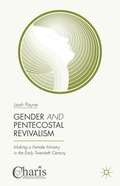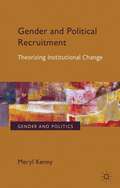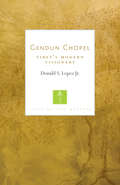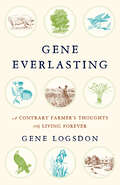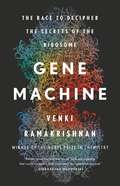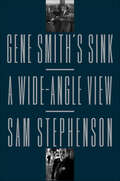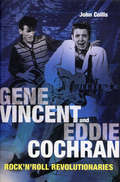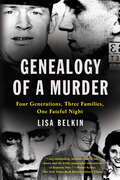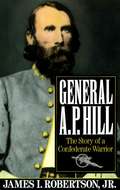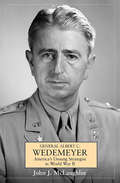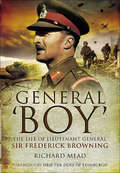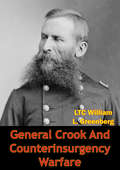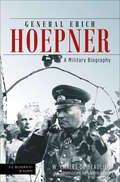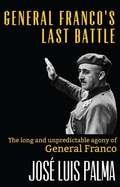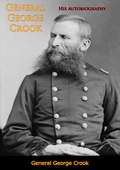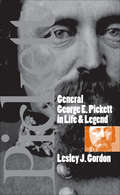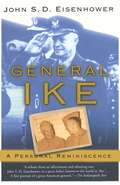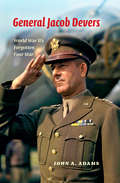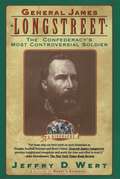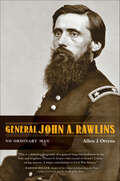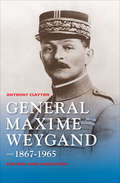- Table View
- List View
Gender and Elections
by Richard L. Fox Susan J. CarrollThe third edition of Gender and Elections offers a systematic, lively, and multifaceted account of the role of gender in the electoral process through the 2012 elections. This timely yet enduring volume strikes a balance between highlighting the most important developments for women as voters and candidates in the 2012 elections and providing a more long-term, in-depth analysis of the ways that gender has helped shape the contours and outcomes of electoral politics in the United States. Individual chapters demonstrate the importance of gender in understanding and interpreting presidential elections, presidential and vice-presidential candidacies, voter participation and turnout, voting choices, congressional elections, the political involvement of Latinas, the participation of African American women, the support of political parties and women's organizations, candidate communications with voters, and state elections. Without question, Gender and Elections is the most comprehensive, reliable, and trustworthy resource on the role of gender in US electoral politics.
Gender and Pentecostal Revivalism
by Leah PayneThis innovative volume provides an interdisciplinary, theoretically innovative answer to an enduring question for Pentecostal/charismatic Christianities: how do women lead churches? This study fills this lacuna by examining the leadership and legacy of two architects of the Pentecostal movement - Maria Woodworth-Etter and Aimee Semple McPherson.
Gender and Political Recruitment
by Meryl KennyThis book explores the gendered dynamics of institutional innovation, continuity and change in candidate selection and recruitment. Drawing on the insights of feminist institutionalism, it extends the 'supply and demand model' of political recruitment via a micro-level case study of the candidate selection process in post-devolution Scotland.
Gendun Chopel: Tibet's Modern Visionary (Committee On Publications In Biology And Medicine Ser.)
by Donald S. LopezThe most comprehensive work available on the life and writings of Tibet's most famous modern cultural hero.Visionary, artist, poet, iconoclast, philosopher, adventurer, master of the arts of love, tantric yogin, Buddhist saint. These are some of the terms that describe Tibet’s modern culture hero Gendun Chopel (1903–1951). The life and writings of this sage of the Himalayas mark a key turning point in Tibetan history, when twentieth-century modernity came crashing into Tibet from British India to the south and from Communist China to the east. For the first time, the astonishing breadth of his remarkable accomplishments is captured in a single, definitive volume. Here is an exploration of Gendun Chopel’s life as a recognized tulku, or incarnation of a previous master, becoming a monk and soon surpassing the knowledge of his teachers, to his travels and discoveries throughout Tibet, India, and Sri Lanka. His exposure to the wider world brought together his philosophical training, artistic virtuosity, and meditative experience, inspiring an incredible corpus of poetry, prose, and painting. While Gendun Chopel was known by the Tibetan establishment for his vast learning and progressive ideas—which eventually landed him in a Lhasa prison—he was little appreciated in his lifetime. However, since his death in 1951 his legacy, fame, and relevance across the Tibetan cultural landscape and beyond have continued to grow.No American scholar knows Gendun Chopel better than Donald Lopez, who has written six books about him, culminating in this volume. Lopez intimately and eloquently carries the reader through the life of Gendun Chopel and sets the stage for his selected writings, which present the range and depth of Gendun Chopel’s thought. The most comprehensive and wide-ranging work available on this extraordinary figure, this inaugural book of the Lives of the Masters series is an instant classic.
Gene Everlasting: A Contrary Farmer's Thoughts on Living Forever
by Gene LogsdonAuthor Gene Logsdon—whom Wendell Berry once called &“the most experienced and best observer of agriculture we have&”—has a notion: That it is a little easier for gardeners and farmers to accept death than the rest of the populace. Why? Because every day, farmers and gardeners help plants and animals begin life and help plants and animals end life. They are intimately attuned to the food chain. They understand how all living things are seated around a dining table, eating while being eaten. They realize that all of nature is in flux.Gene Everlasting contains Logsdon&’s reflections, by turns both humorous and heart-wrenching, on nature, death, and eternity, all from a contrary farmer&’s perspective. He recounts joys and tragedies from his childhood in the 1930s and &‘40s spent on an Ohio farm, through adulthood and child-raising, all the way up to his recent bout with cancer, always with an eye toward the lessons that farming has taught him about life and its mysteries.Whether his subject is parsnips, pigweed, immortality, irises, green burial, buzzards, or compound interest, Logsdon generously applies as much heart and wit to his words as he does care and expertise to his fields.
Gene Machine: The Race to Decipher the Secrets of the Ribosome
by Venki RamakrishnanA Nobel Prize-winning biologist tells the riveting story of his race to discover the inner workings of biology's most important molecule"Ramakrishnan's writing is so honest, lucid and engaging that I could not put this book down until I had read to the very end."--Siddhartha Mukherjee, author of The Emperor of All Maladies and The Gene Everyone has heard of DNA. But by itself, DNA is just an inert blueprint for life. It is the ribosome--an enormous molecular machine made up of a million atoms--that makes DNA come to life, turning our genetic code into proteins and therefore into us. Gene Machine is an insider account of the race for the structure of the ribosome, a fundamental discovery that both advances our knowledge of all life and could lead to the development of better antibiotics against life-threatening diseases. But this is also a human story of Ramakrishnan's unlikely journey, from his first fumbling experiments in a biology lab to being the dark horse in a fierce competition with some of the world's best scientists. In the end, Gene Machine is a frank insider's account of the pursuit of high-stakes science.
Gene Smith's Sink: A Wide-Angle View
by Sam StephensonAn incisive biography of the prolific photo-essayist W. Eugene SmithFamously unabashed, W. Eugene Smith was photography’s most celebrated humanist. As a photo essayist at Life magazine in the 1940s and ’50s, he established himself as an intimate chronicler of human culture. His photographs of war and disaster, villages and metropolises, doctors and midwives, revolutionized the role of images in journalism, transforming photography for decades to come.When Smith died in 1978, he left behind eighteen dollars in the bank and forty-four thousand pounds of archives. He was only fifty-nine, but he was flat worn-out. His death certificate read “stroke,” but, as was said of the immortal jazzman Charlie Parker, Smith died of “everything,” from drug and alcohol benders to weeklong work sessions with no sleep.Lured by the intoxicating trail of people that emerged from Smith’s stupefying archive, Sam Stephenson began a quest to trace his footsteps. In Gene Smith’s Sink, Stephenson merges traditional biography with rhythmic digressions to revive Smith’s life and legacy. Traveling across twenty-nine states, Japan, and the Pacific, Stephenson profiles a lively cast of characters, including the playwright Tennessee Williams, to whom Smith likened himself; the avant-garde filmmaker Stan Brakhage, with whom he once shared a Swiss chalet; the artist Mary Frank, who was married to his friend Robert Frank; the jazz pianists Thelonious Monk and Sonny Clark, whose music was taped by Smith in his loft; and a series of obscure caregivers who helped keep Smith on his feet. The distillation of twenty years of research, Gene Smith’s Sink is an unprecedented look into the photographer’s potent legacy and the subjects around him.
Gene Vincent & Eddie Cochran
by John CollisThe United Kingdom had never seen anything like it, as two rock'n'roll legends rampaged around the country on Britain's first-ever rock tour. Gene Vincent and Eddie Cochran lived the rock'n'roll lifestyle to the full, bringing to an end the monochrome 1950s and ushering in the swinging 60s.John Collis has traced the story of the UK tour that was a defining moment in British popular culture to its tragic climax with the death of Eddie Cochran. He looks back on the contrasting backgrounds of the two stars, follows the tale onwards to Gene Vincent's death from alcohol and drug abuse, and examines the lasting legacy of their music.
Genealogy of a Murder: Four Generations, Three Families, One Fateful Night
by Lisa Belkin“[An] exhilarating, intimate study of fate, chance and the wildly meaningful intersections of disparate lives.” —Robert Kolker, New York Times Book Review, Editors’ Choice A Next Big Idea Club Must-Read Book for May 2023 The multigenerational tale of three families whose paths collide one summer night in 1960 with the murder of a police officer. Independence Day weekend, 1960: a young cop is murdered, shocking his close-knit community in Stamford, Connecticut. The killer remains at large, his identity still unknown. But on a beach not far away, a young Army doctor, on vacation from his post at a research lab in a maximum-security prison, faces a chilling realization. He knows who the shooter is. In fact, the man—a prisoner out on parole—had called him only days before. By helping his former charge and trainee, the doctor, a believer in second chances, may have inadvertently helped set the murder into motion. And with that one phone call, may have sealed a policeman’s fate. Alvin Tarlov, David Troy, and Joseph DeSalvo were all born of the Great Depression, all with grandparents who’d left different homelands for the same American Dream. How did one become a doctor, one a cop, and one a convict? In Genealogy of a Murder, journalist Lisa Belkin traces the paths of each of these three men—one of them her stepfather. Her canvas is large, spanning the first half of the 20th century: immigration, the struggles of the working class, prison reform, medical experiments, politics and war, the nature/nurture debate, epigenetics, the infamous Leopold and Loeb case, and the history of motorcycle racing. It is also intimate: a look into the workings of the mind and heart. Following these threads to their tragic outcome in July 1960, and beyond, Belkin examines the coincidences and choices that led to one fateful night. The result is a brilliantly researched, narratively ingenious story, which illuminates how we shape history even as we are shaped by it.
General A. P. Hill: The Story of a Confederate Warrior
by James I. Robertson Jr.A Confederate general who ranks with Lee, Jeb Stuart, and Stonewall Jackson but whose achievements have been unfairly neglected until now, finally receives his due in this invaluable biography by a noted historian of the Civil War. Drawing extensively on newly unearthed documents, this work provides a gripping battle-by-battle assessment of Hill's role in Antietam, Fredericksburg, Gettysburg, and other battles.
General Albert C. Wedemeyer
by John J. MclaughlinLike many heroes of the Second World War, General Albert C. Wedemeyer's career has been largely overshadowed by such well-known figures as Marshall, Patton, Montgomery, and Bradley. Wedemeyer's legacy as the main planner of the D-Day invasion is almost completely forgotten today, eclipsed by politics and the capriciousness of human nature. Yet during America's preparation for the war, Wedemeyer was the primary author of the "Victory Program" that mobilized US resources and directed them at crucial points in order to secure victory over the Axis. In the late 1930s, he had the unique experience of being an exchange student at the German Kriegsakademia, the Nazis' equivalent of Fort Leavenworth's Command and General Staff School. As the only American to attend, he was thus the only ranking officer in the US who recognized the tactics of blitzkrieg once they were unleashed, and he knew how to respond. As US involvement in the European conflagration approached, Wedemeyer was taken under the wing of George C. Marshall in Washington. Wedemeyer conceived the plans for US mobilization, which was in greater gear than realized at the time of Pearl Harbor. The Victory Program, completed in the summer of 1941, contained actual battle plans and called for the concentration of forces in England in preparation for an early cross-channel invasion into France. However, to Wedemeyer's great disappointment (reflecting Marshall's), he was not appointed to field command in the ETO once the invasion commenced; further, he had run afoul of Winston Churchill due to the latter's insistence on emphasizing the Mediterranean theater in 1943. Perhaps because of Churchill's animosity, Wedemeyer was transferred to the Burma-China theater, where a year later he would replace General Stilwell. Ultimately, Wedemeyer's service in the Asian theater became far more significant, though less known. Had the US political establishment listened to Wedemeyer's advice on China during the years 1943-48, it is possible China would not have been lost to the Communists and would have been a functioning US ally from the start, thus eliminating the likelihood of both the Korean and Vietnam Wars. Despite Wedemeyer's key position at the crux of modern history, his contributions have been overlooked in most accounts of World War II and the Cold War beyond. In this work, we gain an intimate look at a visionary thinker who helped guide the Allies to victory in their greatest challenge, but whose vision of the post-war world was unfortunately not heeded.
General Boy: The Life of Lieutenant General Sir Frederick Browning
by Richard MeadThis is the first biography of Boy Browning, whose name is inextricably linked with the creation and employment of Britains airborne forces in the Second World War. Commissioned into the Grenadier Guards, Browning served on the Western Front, earning a DSO during the Battle of Cambrai. As Adjutant at Sandhurst, he began the tradition of riding a horse up the steps at the end of the commissioning parade. Browning represented England and Great Britain as a hurdler at the 1928 Winter Olympics. In 1932 Browning married Daphne du Maurier, who was ten years younger and became one of the 20th centurys most enduring and popular novelists with titles such as Jamaica Inn and Rebecca. Browning commanded two brigades before being appointed to command 1 Airborne Division in 1941, later acting as Eisenhowers advisor on airborne warfare in the Mediterranean. In 1944 he commanded 1st Airborne Corps, which he took to Holland for Operation MARKET GARDEN that September. Allegedly coining the phrase a bridge too far, he has received much of the blame for the operations failure.In late 1944, Browning became Chief of Staff to Mountbatten. In 1948 he became Comptroller and Treasurer to Princess Elizabeth and Prince Philip and then Treasurer to the latter following the Queens accession. He was a close adviser to the Royal couple, who respected and valued his judgment.By this time, Boy and Daphne lived separate lives with Boy working at the Palace in London and Daphne reluctant to leave her beloved Cornwall although the marriage remained intact. Questions exist as to Daphnes sexuality and Boy had a succession of discrete mistresses. After a nervous breakdown probably due to marriage problems, he resigned in 1959 and retired to Cornwall. Browning died in March 1965.
General Crook And Counterinsurgency Warfare
by LTC William L. GreenbergThis thesis investigates the operational and tactical procedures in counterinsurgency warfare developed by General George Crook while commanding U.S. Army forces in southwest and the northern plains. This work includes a brief introduction of General Crook's career before and during the Civil War. The study examines the capabilities of the U.S. Army and its Apache and Sioux opponents during Indian campaigns, which Crook participated in. Inherent in the study is an in-depth examination of Crook's campaigns against the Apaches in the 1872-75, 1882-86, and against the Sioux and Cheyenne in 1876-77.This study concludes that General Crook, through trial and error, developed a distinct brand of operational and tactical procedures to conduct effective counterinsurgency warfare. Though lacking a coherent strategic national policy concerning the Indians, Crook was capable of successfully developing and executing a coherent counterinsurgency policy at the operational and tactical levels. This comprehensive program produced victories against his enemies in the field and an integrated acculturation policy for the Indians who resided on the reservation. Crook's use of Apache scouts and the pack mule train revolutionized the Army's ability to track down the insurgents and defeat them. His use of population controls coupled with economic development provided his Indian opponents an alternative way of life for their societies.
General Erich Hoepner: A Military Biography (Die Wehrmacht im Kampf)
by Chales de BeaulieuWritten by Hoepner's chief of staff on the Eastern Front, this military biography of the German WWII general is available in English for the first time.This biography of Erich Hoepner was written by Walter Chales de Beaulieu, a general staff officer who fought alongside him. It examines his leadership of panzer formations in Poland in 1939, France in 1940, and Russia in 1941. Hoepner was one of the most competent tank commanders of World War II, playing a significant role in Germany’s early successes. As the commander of the XVI Panzer Corps in 1939, Hoepner carried out the main thrust towards Warsaw, reaching the outskirts of the city in only eight days. With the same formation, he fought the French Cavalry Corps in Belgium, partook in the encirclement of Allied forces near Dunkirk, and advanced southwards over the Weygand Line deep into French territory. In 1941, Hoepner became the commander of Panzer Group 4, the main attack formation for the advance on Leningrad. In this book, Walter Chales de Beaulieu provides insight into Erich Hoepner’s ability as a panzer commander, painting a picture of a man who was committed to the military profession.
General Franco's Last Battle: The long and unpredictable agony of General Franco
by José Luis Palma Isabelle ChaizeThe youngest member of the medical team that treated General Francisco Franco during his long final agony tells the story of the turbulent days between the 15th of October and the 20th of November 1975. This is a non-fiction novel of great literary and historical value. As the author says in the book, 'with the passage of time I have convinced myself that Franco died because of his own doctors. I think we exhausted him too much, gave him too many orders - for a hard person, for a dictator, it must be unbearable.'
General George Crook: His Autobiography [Second Edition]
by Martin F. Schmitt Gen. George CrookGeneral George Crook spent his entire military career, with the exception of the Civil War years, on the frontier. Fighting the Indians, he earned the distinction of being the lowest-ranking West Point cadet ever to rise to the rank of major-general.Crook’s autobiography covers the period from his graduation from West Point in 1852 to June 18, 1876, the day after the famous Battle of the Rosebud. Editor Martin F. Schmitt has supplemented Crook’s life story with other material from the general’s diaries and letters and from contemporary newspapers.“When Red Cloud, the Sioux chief, heard of the death of his old antagonist, the Army officer they called Three Stars, he told a missionary, ‘He, at least, never lied to us.’ General Sherman called Crook the greatest Indian fighter and manager the Army ever had. Yet this man who was the most effective campaigner against the Indians had won their respect and trust. To understand why, you ought to read General George Crook: His Autobiography, edited and annotated by Martin F. Schmitt.”—Los Angeles Times“A story straightforward, accurate, and interesting, packed with detail and saturated with a strong western flavor....The importance of this book lies not merely in its considerable contribution to our knowledge of military history and to the intimate and sometimes trenchant remarks made by Crook about his colleagues, but more particularly in the revelation of the character and aims of the general himself.”—Chicago Tribune
General George E. Pickett in Life and Legend
by Lesley J. GordonThe man who gave his name to the greatest failed frontal attack in American military history, George E. Pickett is among the most famous Confederate generals of the Civil War. But even today he remains imperfectly understood, a figure shrouded in Lost Cause mythology. In this carefully researched biography, Lesley Gordon moves beyond earlier studies of Pickett. By investigating the central role played by his wife LaSalle in controlling his historical image, Gordon illuminates Pickett's legend as well as his life. After exploring Pickett's prewar life as a professional army officer trained at West Point, battle-tested in Mexico, and seasoned on the western frontier, Gordon traces his return to the South in 1861 to fight for the Confederacy. She examines his experiences during the Civil War, including the famed, but failed, charge at the battle of Gettysburg, and charts the decline in his career that followed. Gordon also looks at Pickett's marriage in 1863 to LaSalle Corbell, like him a child of the Virginia planter elite. Though their life together lasted only twelve years, LaSalle spent her five decades of widowhood writing and speaking about her husband and his military career. Appointing herself Pickett's official biographer, she became a self-proclaimed authority on the war and the Old South. In fact, says Gordon, LaSalle carefully and deliberately created a favorable image of her husband that was at odds with the man she had married."Lesley Gordon's study of George E. Pickett explores the reality of the general's life as well as its romanticized version that survived through the generations. . . . Excellent military history informed by recent scholarship in social history, General George E. Pickett in Life and Legend provides a sophisticated analysis of one of the Civil War's most memorable figures."--Journal of Southern History"Insightful and judicious, sometimes unconventional, and combining a clear narrative thread with a persuasive analysis of available evidence, [this] biography is a convincing assessment of George Pickett's place in Confederate history, an intriguing examination of his--and LaSalle's--character and personality, and a valuable look at the Pickett of legend."--Civil War History"The novelty of this elegantly written book resides in the degree to which Gordon, rather than relying heavily on LaSalle, complaining about her, or both, as previous researchers have done, carefully sifts through her various accounts and separates fact from fiction--and suggests the truths that reside in fiction."--Journal of American HistoryThe man who gave his name to the greatest failed frontal attack in American military history, George E. Pickett is among the most famous Confederate generals of the Civil War. But even today he remains imperfectly understood, a figure shrouded in Lost Cause mythology. In this carefully researched biography, Lesley Gordon moves beyond earlier studies of Pickett. By investigating how Pickett's wife LaSalle, who outlived her husband by five decades, helped control his historical image, Gordon illuminates Pickett's legend as well as his life. -->
General George Washington: A Military Life
by Edward G. LengelMuch has been written in the past two centuries about George Washington the statesman and “father of his country.” Less often discussed is Washington’s military career, including his exploits as a young officer and his performance as the Revolutionary War commander in chief. Now, in a revealing work of historical biography, Edward Lengel has written the definitive account of George Washington the soldier.Based largely on Washington’s personal papers, this engrossing book paints a vivid, factual portrait of a man to whom lore and legend so tenaciously cling. To Lengel, Washington was the imperfect commander. Washington possessed no great tactical ingenuity, and his acknowledged “brilliance in retreat” only demonstrates the role luck plays in the fortunes of all great men. He was not an enlisted man’s leader; he made a point of never mingling with his troops. He was not an especially creative military thinker; he fought largely by the book. He was not a professional, but a citizen soldier, who, at a time when warfare demanded that armies maneuver efficiently in precise formation, had little practical training handling men in combat. Yet despite his flaws, Washington was a remarkable figure, a true man of the moment, a leader who possessed a clear strategic, national, and continental vision, and who inspired complete loyalty from his fellow revolutionaries, officers, and enlisted men. America could never have won freedom without him.A trained surveyor, Washington mastered topography and used his superior knowledge of battlegrounds to maximum effect. He appreciated the importance of good allies in times of crisis, and understood well the benefits of coordination of ground and naval forces. Like the American nation itself, he was a whole that was greater than the sum of its parts–a remarkable everyman whose acts determined the course of history. Lengel argues that Washington’s excellence was in his completeness, in how he united the military, political, and personal skills necessary to lead a nation in war and peace. At once informative and engaging, and filled with some eye-opening revelations about Washington, the war for American independence, and the very nature of military command, General George Washington is a book that reintroduces readers to a figure many think they already know.
General He Yingqin
by Peter WorthingA revisionist study of the career of General He Yingqin, one of the most prominent military officers in China's Nationalist period (1928–1949) and one of the most misunderstood figures in twentieth-century China. Western scholars have dismissed He Yingqin as corrupt and incompetent, yet the Chinese archives reveal that he demonstrated considerable success as a combat commander and military administrator during civil conflicts and the Sino-Japanese War. His work in the Chinese Nationalist military served as the foundation of a close personal and professional relationship with Chiang Kai-shek, with whom he worked closely for more than two decades. Against the backdrop of the Nationalist revolution of the 1920s through the 1940s, Peter Worthing analyzes He Yingqin's rise to power alongside Chiang Kai-shek, his work in building the Nationalist military, and his fundamental role in carrying out policies designed to overcome the regime's greatest obstacles during this turbulent period of Chinese history.
General Ike
by John EisenhowerJohn S.D. Eisenhower modestly explains General Ike as "a son's view of a great military leader -- highly intelligent, strong, forceful, kind, yet as human as the rest of us." It is that, and more: a portrait of the greatest Allied military leader of the Second World War, by the man who knew Ike best. General Ike is a book that John Eisenhower always knew he had to write, a tribute from an affectionate and admiring son to a great father. John chose to write about the "military Ike," as opposed to the "political Ike," because Ike cared far more about his career in uniform than about his time in the White House. A series of portraits of Ike's relations with soldiers and statesmen, from MacArthur to Patton to Montgomery to Churchill to de Gaulle, reveals the many facets of a talented, driven, headstrong, yet diplomatic leader. Taken together, they reveal a man who was brilliant, if flawed; naÏve at times in dealing with the public, yet who never lost his head when others around him were losing theirs. Above all, General Ike was a man who never let up in the relentless pursuit of the destruction of Hitler. Here for the first time are eyewitness stories of General Patton showing off during military exercises; of Ike on the verge of departing for Europe and assuming command of the Eastern Theater; of Churchill stewing and lobbying Ike in his "off hours." Faced with giant personalities such as these men and MacArthur, not to mention difficult allies such as de Gaulle and Montgomery, Ike nevertheless managed to pull together history's greatest invasion force and to face down a determined enemy from Normandy to the Bulge and beyond. John Eisenhower masterfully uses the backdrop of Ike's key battles to paint a portrait of his father and his relationships with the great men of his time. General Ike is a ringing and inspiring testament to a great man by an accomplished historian. It is also a personal portrait of a caring, if not always available, father by his admiring son. It is history at its best.
General Jacob Devers: World War II's Forgotten Four Star
by John A. AdamsA &“solid and informative&” biography of one of the overlooked heroes of the Second World War (Wall Street Journal). Of the leaders of the American Army in World War II, Jacob Devers is undoubtedly the &“forgotten four-star.&” Plucked from relative obscurity in the Canal Zone, Devers was one of four generals selected by General of the Army George Marshall in 1941 to assist him in preparing the Army for war. He quickly became known in Army circles for his &“can do&” attitude and remarkable ability to cut through red tape. Among other duties, he was instrumental in transforming Ft. Bragg, then a small Army post, into a major training facility. As head of the armored force, Devers contributed to the development of a faster, more heavily armored tank, equipped with a higher velocity gun that could stand up to the more powerful German tanks, and helped to turn American armor into an effective fighting force. In spring 1943, Devers replaced Dwight Eisenhower as commander of the European Theater of Operations, then was given command of the 6th Army Group that invaded the south of France and fought its way through France and Germany to the Austrian border. In the European campaign to defeat Hitler, Eisenhower had three subordinate army group commanders: British Field Marshall Bernard Montgomery, Omar S. Bradley, and Jacob Devers. The first two are well-known; here the third receives the attention he properly deserves.
General James Longstreet: The Confederacy's Most Controversial Soldier
by Jeffry D. WertGeneral James Longstreet fought in nearly every campaign of the Civil War, from Manassas (the first battle of Bull Run) to Antietam, Fredericksburg, Chickamauga, Gettysburg, and was present at the surrender at Appomattox. Yet, he was largely held to blame for the Confederacy's defeat at Gettysburg. General James Longstreet sheds new light on the controversial commander and the man Robert E. Lee called “my old war horse.”
General John A. Rawlins: No Ordinary Man
by Allen J. OttensNo one succeeds alone, and Ulysses S. Grant was no exception. From the earliest days of the Civil War to the heights of Grant's power in the White House, John A. Rawlins was ever at Grant's side. Yet Rawlins's role in Grant's career is often overlooked, and he barely received mention in Grant's own two-volume Memoirs. General John A. Rawlins: No Ordinary Man by Allen J. Ottens is the first major biography of Rawlins in over a century and traces his rise to assistant adjutant general and ultimately Grant's secretary of war. Ottens presents the portrait of a man who teamed with Grant, who submerged his needs and ambition in the service of Grant, and who at times served as the doubter who questioned whether Grant possessed the background to tackle the great responsibilities of the job. Rawlins played a pivotal role in Grant's relatively small staff, acting as administrator, counselor, and defender of Grant's burgeoning popularity. Rawlins qualifies as a true patriot, a man devoted to the Union and devoted to Grant. His is the story of a man who persevered in wartime and during the tumultuous years of Reconstruction and who, despite a ravaging disease that would cut short his blossoming career, grew to become a proponent of the personal and citizenship rights of those formerly enslaved. General John A. Rawlins will prove to be a fascinating and essential read for all who have an interest in leadership, the Civil War, or Ulysses S. Grant.
General Maxime Weygand, 1867-1965: Fortune and Misfortune (Encounters: Explorations in Folklore and Ethnomusicology)
by Anthony ClaytonThis lively biography of the French military commander chronicles his legendary and controversial career through WWI, WWII, and beyond. The extraordinary life of General Maxime de Nimal Weygand offers a fascinating glimpse into the perils and politics of 20th century French military leadership. From obscure origins, Weygand rose to a distinguished career as chief of staff for Marshal Foch during World War I and continued to serve his country after the war in Poland and Syria. Alarmed by Nazi Germany&’s prodigious rearmament, Weygand locked horns with politicians who were blind to the growing military threat. In fact, he faced accusations that his desire for a strong army was anti-democratic. With German invaders again threatening Paris, Weygand argued for armistice rather than face certain military defeat. During Nazi occupation, he was no friend of the newly-installed Vichy government, and was sent to North Africa. There, he plotted the army&’s return to the Allied cause and was imprisoned. Released at wars end, he was rearrested on the orders of Charles de Gaulle and afterwards fought to restore his name. In this concise biography, Anthony Clayton traces the vertiginous changes in fortune of a soldier whose loyalty to France and to the French army was unwavering.
General Patton: A Soldier's Life
by Stanley P. Hirshson"War is my work and I know I sound sometimes as though I liked it; perhaps I do -- how can I tell? -- but this war hurts everybody. " -- Patton to Henry J. Taylor, 1945. General George S. Patton, Jr. , an inspirational leader and outstanding tactician, has intrigued and confounded his biographers. Now, utilizing untapped archival materials in both the United States and England, government documents, family papers, and oral histories, Stanley P. Hirshson creates the most balanced portrait of Patton ever written. It reveals Patton as a complex soldier capable of brilliant military maneuvers but also of inspiring his troops with fiery speeches that resulted in horrendous acts, such as the massacres of Italian civilians, It explains Patton's belief in a soldiers Valhalla, connects the family's wealth to one of Americas bitterest labor strikes, and disputes the usual interpretation of Patton's relief from command of the Third Army. In investigating this complex man, Hirshson has uncovered surprising material about a series of civilian massacres in Sicily, about the two slapping incidents, about attempts to exploit Patton's diary after his death, and about Patton's relations with top Allied generals. Patton emerges as a soldier of great imagination and courage, and his military campaigns make for edge-of-the-seat reading. All the drama of Patton's life comes alive in this meticulously documented volume.

